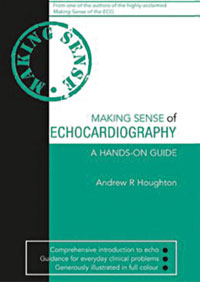Echocardiography is one of the most widely used diagnostic tests for heart disease. To make sense of an echo is a desirable skill for all those involved in cardiology and this compact handbook does just that. The book contains a total of 23 chapters and is split into three logical parts: essential principles, cardiac imaging techniques and clinical cases. Over half of the chapters are dedicated to clinical cases giving it a strong practical emphasis.

Author: Houghton A
Publisher: Hodder Arnold,
London, 2009
ISBN: 978-0-340-950-043
Price: £29.99
Part 1 takes the reader back to basic cardiac anatomy, physiology and physics of ultrasound assuming no prior knowledge. The chapters are well written and complex theory is made into easy reading by boxed key concepts and multiple clear illustrations. This section concludes with a unique chapter entitled ‘Service provision’ which details accreditation programmes, staffing, departmental and quality control issues surrounding an echocardiography service.
Contemporary echocardiography, which now includes many sophisticated techniques such as 3-D, transoesophageal, stress and contrast echo, is concisely described in the second part of the book without overwhelming the reader. The author even provides a short chapter on alternative cardiac imaging techniques, which include nuclear, magnetic resonance, computed tomography and cardiac catheterisation. I am not sure what this brief chapter adds, other than reminding the reader that there is more to imaging than echocardiography! However the real strength of this section is the step-by-step guidance given to a transthoracic echo study. Each standard echo window is depicted with anatomical annotations and the accompanying text describes the modalities to use and the structures to evaluate. This chapter ends with somewhat disappointing tips on echo reporting and may have been better approached with an example report or template.
Although part 3 is entitled ‘Clinical cases’, they are not clinical scenarios. Each chapter details a structure, such as the aortic valve, or a disease process, such as endocarditis. Again, an efficient step-by-step approach is adopted, which makes this an accessible guide. It is mainly written in bullet points with tables, high-quality colour echocardiograms and British Society of Echocardiography (BSE) reference ranges. Calculations are clearly laid out and common pitfalls and tips are helpfully boxed. Latest guidelines are included from diagnostics to management allowing much to be learnt about cardiac medicine as well as echocardiography. Each chapter has a brief sample report illustrating how pathology should be described and the pertinent measurements to be included. Useful references are provided at the end of each chapter for further reading.
This really is a great hands-on introduction to echocardiography and should be recommended reading for cardiology registrars, sonographers, emergency physicians and general practitioners with an interest in echo as well as those preparing for the BSE Transthoracic Echocardiography accreditation examination. Although full of practical imaging advice, the text is written in an engaging tone giving the reader a comprehensive overview. Its accessibility makes it easy to read from cover to cover and more can be gained from the accompanying free website containing 150 video clips. The book’s compact size and excellent layout makes it possible to pack each page with information without being intimidating. It thus empowers the reader to go out and echo.
